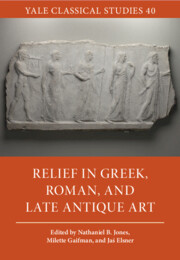Refine search
Actions for selected content:
5894 results in Classical art and architecture
2 - Celebration Time
- from Part I - Patrons and Communities
-
- Book:
- Rebuilding Histories in the Roman World
- Published online:
- 23 November 2025
- Print publication:
- 11 December 2025, pp 87-121
-
- Chapter
- Export citation
Index
-
- Book:
- Rebuilding Histories in the Roman World
- Published online:
- 23 November 2025
- Print publication:
- 11 December 2025, pp 501-514
-
- Chapter
- Export citation
8 - Un-Monumental Histories
- from Part III - “Unmarked” Changes
-
- Book:
- Rebuilding Histories in the Roman World
- Published online:
- 23 November 2025
- Print publication:
- 11 December 2025, pp 367-409
-
- Chapter
- Export citation
Part II - Architectural Autobiographies
-
- Book:
- Rebuilding Histories in the Roman World
- Published online:
- 23 November 2025
- Print publication:
- 11 December 2025, pp 163-304
-
- Chapter
- Export citation
Abbreviations
-
- Book:
- Rebuilding Histories in the Roman World
- Published online:
- 23 November 2025
- Print publication:
- 11 December 2025, pp xxiv-xxvi
-
- Chapter
- Export citation

Rebuilding Histories in the Roman World
- Architectural Restoration and Temporality from Augustus to Justinian
-
- Published online:
- 23 November 2025
- Print publication:
- 11 December 2025

Relief in Greek, Roman, and Late Antique Art
-
- Published online:
- 11 October 2025
- Print publication:
- 25 September 2025
Figures
-
- Book:
- Relief in Greek, Roman, and Late Antique Art
- Published online:
- 11 October 2025
- Print publication:
- 25 September 2025, pp ix-xx
-
- Chapter
- Export citation
7 - Remedial Relief
-
-
- Book:
- Relief in Greek, Roman, and Late Antique Art
- Published online:
- 11 October 2025
- Print publication:
- 25 September 2025, pp 232-258
-
- Chapter
- Export citation
5 - Sculpture, Relief, and the Surrounding Space
-
-
- Book:
- Relief in Greek, Roman, and Late Antique Art
- Published online:
- 11 October 2025
- Print publication:
- 25 September 2025, pp 166-198
-
- Chapter
- Export citation
4 - Relief in Athenian Vase Painting
-
-
- Book:
- Relief in Greek, Roman, and Late Antique Art
- Published online:
- 11 October 2025
- Print publication:
- 25 September 2025, pp 139-165
-
- Chapter
- Export citation
Introduction
-
-
- Book:
- Relief in Greek, Roman, and Late Antique Art
- Published online:
- 11 October 2025
- Print publication:
- 25 September 2025, pp 1-27
-
- Chapter
- Export citation
Index
-
- Book:
- Relief in Greek, Roman, and Late Antique Art
- Published online:
- 11 October 2025
- Print publication:
- 25 September 2025, pp 357-362
-
- Chapter
- Export citation
2 - Thinking through Marble
-
-
- Book:
- Relief in Greek, Roman, and Late Antique Art
- Published online:
- 11 October 2025
- Print publication:
- 25 September 2025, pp 65-107
-
- Chapter
- Export citation
1 - Ancient Relief
-
-
- Book:
- Relief in Greek, Roman, and Late Antique Art
- Published online:
- 11 October 2025
- Print publication:
- 25 September 2025, pp 28-64
-
- Chapter
- Export citation
8 - Foregrounding the Background in Roman Relief Sculpture
-
-
- Book:
- Relief in Greek, Roman, and Late Antique Art
- Published online:
- 11 October 2025
- Print publication:
- 25 September 2025, pp 259-287
-
- Chapter
- Export citation
3 - The Body in Relief in Archaic Funerary Sculpture
-
-
- Book:
- Relief in Greek, Roman, and Late Antique Art
- Published online:
- 11 October 2025
- Print publication:
- 25 September 2025, pp 108-138
-
- Chapter
- Export citation
9 - Encrusted in Ancestors
-
-
- Book:
- Relief in Greek, Roman, and Late Antique Art
- Published online:
- 11 October 2025
- Print publication:
- 25 September 2025, pp 288-320
-
- Chapter
- Export citation
6 - Seeing the Past
-
-
- Book:
- Relief in Greek, Roman, and Late Antique Art
- Published online:
- 11 October 2025
- Print publication:
- 25 September 2025, pp 199-231
-
- Chapter
- Export citation
Contents
-
- Book:
- Relief in Greek, Roman, and Late Antique Art
- Published online:
- 11 October 2025
- Print publication:
- 25 September 2025, pp vii-viii
-
- Chapter
- Export citation
